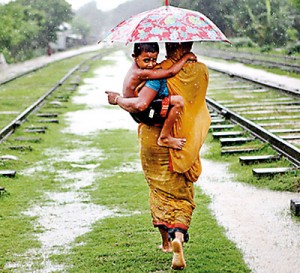Sunday Times 2
Tool to help South Asia manage monsoon woes
[COLOMBO] Better planning combined with frequently updated forecasts could enable South Asia to meet water and energy challenges posed by erratic monsoons, experts say.
According to Frederik Pischke, programme officer at Global Water Partnership (GWP), the Geneva-based intergovernmental organisation, planning starts with preparations ahead of the annual monsoon season that brings in the bulk of the region’s rains, rather than reacting late to excess or inadequate precipitation.
GWP is currently working with the International Water Management Institute, the World Meteorological Organization and South Asian

Image credit: G.M.B. Akash / Panos
governments to set up a new drought-monitoring tool that will allow for better forecasting. Due for launch in April 2015, the tool will continually assess satellite data on vegetation and ground moisture, meteorological data, along with crop information and historical data.
“It is important to get out of the crisis management mentality and get into a mentality of preparedness and planning so that we are one step ahead of disasters like drought and floods, which have increased in frequency and intensity,” Pischke tells SciDev.Net.
In 2013, the monsoon, which typically lasts from June to September moved faster than normal wreaking havoc from the southern coast of Sri Lanka into Nepal. This year the monsoon was scanty over Sri Lanka inflicting an estimated 40 per cent crop loss while unseasonal precipitation caused floods in Pakistan, India and Nepal.
Pischke says GWP updates would be released every eight days and delivered directly to end users like farmers, reservoir managers and help improve coordination among them.
Indra Ediriweera, assistant general manager at Sri Lanka’s National Water Supply and Drainage Board, says there is little coordination between water users like the energy sector and agriculture. “Sometimes water would be released by hydroelectric reservoirs when there is no demand downstream and sometimes farmers will seek water when it needs to be kept in storage for power generation,” he said.
Richard Connor, lead author of World Water and Energy Report 2014 says such confusion is common. “What you need is better coordination between different sectors so that you use water effectively,” he said.Kandeh Yumkella, the UN Secretary-General’s special representative on Suitable Energy for All emphasised the need for planning at the World Water Week in Stockholm in early September. “I think South Asia understands it needs better planning for its water and energy needs. What is needed now is to get policies in place that can achieve this,” he said.
(Courtesy SciDev.net)

